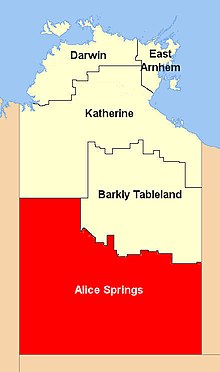Central Australia
This article needs additional citations for verification. (May 2018) |
| Central Australia Northern Territory | |
|---|---|
 Location of the Alice Springs Region | |
 Aerial view of Central Australian landscape | |
 Central Australia | |
| Coordinates | Coordinates: 23°42′0″S 133°52′12″E / 23.70000°S 133.87000°E |
| Population | 41,000 (2016)[1] |
| LGA(s) |
|
Central Australia, also known as the Alice Springs Region (Eastern Arrernte: Mparntwe Ampere), is one of the five regions in the Northern Territory of Australia. The term Central Australia is used to describe an area centred on Alice Springs. It is sometimes referred to as Centralia; likewise the people of the area are sometimes called Centralians. The region is located in the southern part of the Northern Territory spanning from the west on the Western Australian Border to the east on the Queensland border.
Area[]
The main town in Central Australia is Alice Springs; however, this area also includes all of the desert lands surrounding it. Whilst a few of these townships (such as Barrow Creek) are stations (ranches). The region covers an area of 546,046 square kilometres (210,830 sq mi), which makes up forty percent of the Northern Territory.
The following Local Government Areas (LGAs) make up the region:
- Town of Alice Springs (town)
- Central Desert Region (region)
- MacDonnell Region (region)
- Yulara (unincorporated town)
Population[]
The total population of Central Australia is estimated to be 41,000.[1] Alice Springs, the main urban area of Central Australia, is predominantly Anglo-Celtic Australian, with approximately 25% Aboriginal population; however, the surrounding communities which make up Central Australia are almost exclusively Aboriginal. All together, the population of the region is between 40% to 45% Aboriginal.
Climate[]
The region is very dry, and has a tropical climate receiving on average just 150 millimetres (6 in) of rainfall annually.[2]
See also[]
- Central Australia (territory), Australian federal territory 1927–1931
- Regions of the Northern Territory
- Centre points of Australia
References[]
- ^ a b "NT regional economic profiles". Department of Trade, Business and Innovation. Northern Territory Government. 18 April 2016. Retrieved 11 August 2017.
- ^ Laity, Julie J. (2009). Deserts and Desert Environments. John Wiley & Sons. pp. 43, 45. ISBN 978-1444300741. Retrieved 8 November 2012.
External links[]
| Wikivoyage has a travel guide for Red Centre. |
- Regions of the Northern Territory
